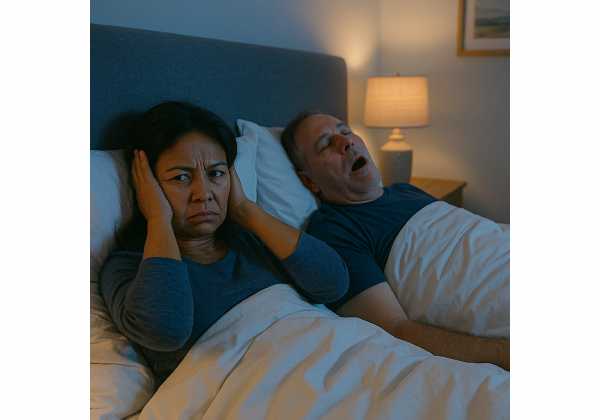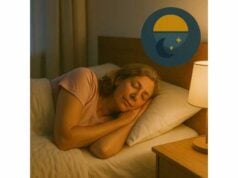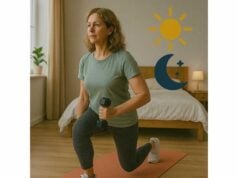
Snoring without obstructive sleep apnea is common in midlife and later life. It often worsens with nasal congestion, lower muscle tone during sleep, or weight gain. Even when apnea is absent, snoring can still disturb a bed partner, fragment sleep, and strain morning energy. The goal of this guide is practical: explain why snoring happens, separate nuisance from risk, and outline specific levers—nasal care, position, devices, timing, and lifestyle—that consistently reduce noise and improve rest. If you want a wider view of how nightly recovery supports healthy aging, see our pillar on sleep, stress, and recovery for healthspan. Then return here to choose one or two targeted changes each week. Small adjustments, done consistently, usually outperform heroic fixes. You do not need to overhaul everything at once—start with the clearest culprit and build from there.
Table of Contents
- Why Snoring Happens: Anatomy, Congestion, and Muscle Tone
- Risks Beyond Noise: Blood Pressure and Daytime Fatigue
- Nasal Strategies: Rinses, Humidification, and Decongestants
- Positional Therapy and Anti Snore Devices
- Weight, Alcohol, and Late Meals: Modifiable Factors
- When to Test for Apnea Despite Mild Snoring
- Tracking Snoring: Apps, Bed Partners, and Wearables
Why Snoring Happens: Anatomy, Congestion, and Muscle Tone
Snoring is sound. Specifically, it is tissue vibration in a narrowed upper airway as air moves through during sleep. In aging, three influences tend to converge: anatomical crowding, impaired nasal airflow, and lower neuromuscular tone in the pharynx.
Anatomy and the “soft tube.” Your upper airway is a flexible passage. When you lie down, gravity shifts the tongue and soft palate backward. A crowded nasal cavity, a long soft palate, bulky tonsillar tissue (less common in older adults), or a recessed lower jaw can all reduce cross-sectional area. The narrower the passage, the faster the air must flow to deliver the same volume, which increases turbulence and tissue vibration—snoring.
Nasal airflow matters more than most people think. The nose warms, humidifies, and resists incoming air. If nasal resistance rises—from allergies, a deviated septum, or dry air—you instinctively mouth-breathe. Mouth breathing lowers the jaw and opens the lips, which slackens the soft palate and tongue base. That combination promotes snoring even without apnea. Night-to-night variability in snoring often tracks nasal status: colds, seasonal pollen, or a dry, heated bedroom can double a person’s snoring minutes.
Muscle tone and sleep stage. In REM sleep, the body naturally reduces muscle tone, including in the airway dilators. Aging brings modest declines in neuromuscular responsiveness at sleep onset and during REM. Alcohol, sedatives, and heavy late meals amplify that relaxation. The result is a looser, more collapsible airway and louder snoring—especially in the second half of the night.
Why snoring can worsen with age (even without weight gain):
- Reduced tissue elasticity and slower reflexes in airway muscles.
- More nasal dryness or congestion due to medications (anticholinergics, some antihypertensives), indoor heating, or chronic rhinitis.
- Less time in deep, stable sleep and more time in lighter stages, where arousals and position changes occur.
Good news: Because multiple small factors add up, small, targeted changes often subtract noise. Improving nasal airflow, raising head and torso, and adjusting sleep timing can reduce snoring without complex equipment. In later sections, you will find stepwise protocols that match common patterns—congested snorer, back-sleeper snorer, occasional alcohol snorer, and “normal BMI but noisy” snorer.
Risks Beyond Noise: Blood Pressure and Daytime Fatigue
Primary (non-apneic) snoring is often dismissed as a social problem. Yet in midlife, the story is more nuanced. Snoring can fragment sleep for the bed partner and the snorer alike, and it may correlate with cardiometabolic strain. The strength of these links varies across studies, but several themes are consistent and practical for decision-making.
Blood pressure: Habitual snoring can track with higher odds of uncontrolled hypertension in community and clinic cohorts. Mechanisms are plausible: repeated vibration may irritate local tissues, raise sympathetic drive, and sustain micro-arousals that elevate overnight and morning blood pressure. Night-to-night alcohol, nasal obstruction, or back-sleeping can intensify this effect. Importantly, the risk is about patterns over months, not a single noisy weekend. If you have snoring plus treated but labile blood pressure—especially early-morning spikes—it is reasonable to address snoring triggers and monitor home blood pressure for several weeks.
Daytime fatigue and mood: Even when apnea is absent, frequent snoring can accompany subtle arousals—micro-wakefulness too brief to remember. These fragments push you toward lighter sleep and reduce sleep efficiency. The day after a fragmented night feels different: less sustained focus, lower motivation to exercise, and more irritability. If a bed partner notices loud, intermittent snoring and you consistently feel unrefreshed, treat it like a performance issue, not a personality flaw: test changes to reduce noise and watch how your mornings respond.
Vascular considerations: Research links heavy habitual snoring to remodeling in nearby vessels, particularly the carotids. The proposed mechanism is vibratory stress transmitted through soft tissues. This does not mean every snorer faces vascular disease; it does suggest that long-standing, loud snoring deserves attention alongside conventional risk management—blood pressure, lipids, exercise, and glucose control.
Decision cues for action:
- You snore most nights and wake with a dry mouth or sore throat.
- Morning blood pressure is high despite medication.
- You or your partner notice frequent, noisy bursts clustered in back-sleeping or after late alcohol.
- You feel tired despite adequate time in bed.
If one or more cues apply, it is reasonable to run a four-week trial: nasal care + positional strategy + alcohol timing. Track snoring minutes (or partner-rated scale) and morning blood pressure. Improvements in both often appear together. For a broader view of autonomic balance and overnight recovery, see HRV fundamentals.
Nasal Strategies: Rinses, Humidification, and Decongestants
If you fix only one thing, fix your nose. Nasal resistance sets the stage for mouth breathing and soft-palate flutter, two reliable ingredients for snoring. Build a simple, evidence-guided nasal routine and apply it consistently for two to four weeks before judging results.
1) Saline rinses (once or twice daily).
A low-pressure saline rinse—squeeze bottle or neti pot—flushes allergens, dust, and thick mucus. Use isotonic saline (about 0.9% NaCl); warm to body temperature to reduce irritation. Technique matters more than brand: lean forward over a sink, mouth open, and let gravity do most of the work. Rinse before bed on high-pollen days, after flights, or when indoor air feels dry. Many snorers notice immediate nasal openness and quieter sleep that night.
2) Humidification and bedroom air.
Aim for 40–55% relative humidity at night. Too dry and nasal tissue cracks; too humid and dust mites flourish. A portable, easy-to-clean humidifier is the best tool in winter or desert climates. Change filters as recommended and clean the tank to prevent biofilm. Pair humidification with regular dust control and, if needed, high-efficiency particulate air (HEPA) filtration to lower indoor allergens.
3) Topical nasal steroids (for allergic or inflammatory congestion).
For allergic rhinitis or perennial nasal inflammation, a once-daily intranasal corticosteroid can reduce swelling and improve airflow after several days, with full effect by 2–4 weeks. Use correct technique: point the nozzle slightly outward (toward the ear) to avoid septal irritation, and sniff gently. These sprays do not work like decongestant drops; they require daily consistency. If you prefer a non-steroidal path, consider intranasal antihistamines for acute allergic flares.
4) Decongestants: when and how.
- Topical (e.g., oxymetazoline): Useful for short bursts—a severe cold or a critical travel night. Limit to ≤3 consecutive nights to avoid rebound congestion.
- Oral (e.g., pseudoephedrine): Can open the nose but may raise heart rate and blood pressure or interact with other medications; avoid near bedtime if it makes you wired.
- Saline first: Many people rely on decongestants when a proper saline/humidification routine would control symptoms with fewer side effects.
5) Structural concerns.
A markedly deviated septum, large inferior turbinates, or nasal valve collapse can keep resistance high despite optimal self-care. Signs include unilateral blockage that never clears, loud breathing during the day, and obligate mouth breathing. An ENT exam—often including endoscopy—can clarify anatomy. Procedural options range from office-based turbinate reduction to septoplasty.
Putting it together: a two-week nasal plan
- Daily: Morning and evening saline rinse; bedtime humidifier set between 40–55%.
- If allergies: Add a nightly intranasal steroid; reassess after week two.
- Travel or colds: Use a topical decongestant for up to three nights.
- If persistent blockage: Seek evaluation for structural contributors.
Good nasal airflow reduces mouth breathing, stabilizes the soft palate, and lowers vibration. Pair these steps with positional adjustments (next section) for the biggest payoff. For additional mouth-nose alignment strategies, see nasal health and mouth breathing.
Positional Therapy and Anti Snore Devices
Snoring is rarely uniform across positions. For many people, it is position-dependent—loudest supine (on the back), quieter on the side, and quietest when the head and torso are slightly elevated. Two categories of tools help: positional therapy and oral devices.
Positional therapy basics
- Side-sleeping supports: A firm body pillow or two stacked pillows behind the back reduces roll-overs. A light pillow between the knees can align the hips and make side-sleeping comfortable for longer stretches.
- Head-of-bed elevation: Raising the head and upper torso 10–20 degrees (using a wedge pillow or an adjustable base) increases airway space and reduces soft-palate flutter. Simple tests—like a few nights with added pillow height—often show clear differences in snoring minutes.
- Vibration trainers and specialty pillows: Some devices gently buzz when you roll onto your back. Specialty pillows aim to keep the jaw closed and head rotated. Their effectiveness varies by anatomy and adherence. Try low-cost methods first (body pillow, wedge) and escalate only if needed.
Oral devices (mandibular advancement) for primary snoring
- How they work: A custom mandibular advancement device (MAD) brings the lower jaw forward a few millimeters during sleep, enlarging the retrolingual space and stiffening upper-airway tissues.
- Who benefits: Best for mouth-open snorers, retrognathia (recessed chin), or those whose snoring persists despite nasal and positional fixes.
- Fitting and titration: A dentist trained in sleep medicine takes impressions and incrementally advances the device to balance snoring reduction with comfort. Temporary boil-and-bite devices can be a low-risk trial, but custom devices are more durable and tolerable.
- Side effects and monitoring: Jaw soreness or dental changes can occur. Regular dental checks mitigate risk. Many users pair a MAD with head-of-bed elevation for additive benefit.
Mouth tape and chin straps: proceed thoughtfully
- Mouth tape: The goal is nasal breathing, not sealing the mouth shut. Use only if you can breathe comfortably through your nose when awake. Test for a few minutes during the day first.
- Chin straps: These can keep the jaw from dropping but may not change tongue position; they sometimes help when combined with a nasal-opening routine.
A practical testing sequence
- Week 1: Add a body pillow for side-sleeping and elevate head/torso 10–20 degrees.
- Week 2: If snoring persists, test a temporary boil-and-bite MAD on side-sleeping nights.
- Weeks 3–4: If the test lowers snoring and is comfortable, consult a dental sleep professional for custom fitting.
- At any step: If the bed partner still notes loud snoring, or if there are witnessed pauses or choking, proceed to the testing section below.
If you need a refresher on setting up the room for quiet, restorative nights—dark, cool, and low noise—see bedroom optimization for complementary tips that support positional strategies.
Weight, Alcohol, and Late Meals: Modifiable Factors
You can do a lot without equipment by changing timing and load on the airway. Three levers carry the most weight: body mass, alcohol, and meal timing.
Body weight and snoring intensity
Even a 5–10% weight reduction can decrease fat deposition around the tongue base and lateral pharyngeal walls, widening the airway. In older adults, strength training plus a moderate caloric deficit preserves lean mass while trimming central fat. Track what matters: belt notch changes, waist circumference, and whether a bed partner reports quieter nights.
Alcohol timing and dose
Alcohol relaxes airway dilator muscles and blunts arousal thresholds. The net effect is louder, more frequent snoring and more awakenings in the second half of the night. Practical guardrails:
- Front-load intake with dinner and finish 3–4 hours before lights-out.
- Cap total ethanol (for many adults, that means limiting to one standard drink or skipping on nights when performance matters).
- Expect higher resting heart rate and lighter sleep after drinking; plan earlier nights alcohol-free when you need your best morning energy.
If you notice snoring spikes after even small doses, reserve alcohol for earlier in the evening or specific social plans.
Late meals and reflux
A full stomach near bedtime can push up the diaphragm, raise intra-abdominal pressure, and worsen reflux, which irritates the throat and can inflame the soft palate and uvula. Aim for a 2–3 hour window between the last full meal and lights-out. For people who wake hungry at 3 a.m., a small, balanced snack (e.g., yogurt with berries or a few whole-grain crackers with cheese) may stabilize the night without spiking reflux.
Caffeine and snoring—indirect but relevant
Caffeine itself does not directly cause snoring, but late caffeine delays sleep and pushes REM into the early morning hours, when airway tone is lowest. Keep larger doses (≥200–300 mg) out of the final 8–10 hours before bed, and scan labels on pre-workouts and analgesics.
Activity and timing
Moderate aerobic activity most days improves nasal airflow and supports weight control. Finish vigorous exercise 2–3 hours before bed if it leaves you hot and alert; earlier sessions pair better with deep, stable sleep.
Putting it together: a weekend strategy
- Pick two quiet nights (no alcohol) each week to reset your baseline.
- On social nights, finish drinks with dinner, hydrate, and elevate the head of the bed.
- Move dinner earlier on workdays; if hungry near bedtime, choose a small, low-acid snack.
- Reassess snoring minutes and morning energy after two weeks.
For a deeper dive on timing rules that protect sleep across caffeine, alcohol, and meals, see practical timing rules.
When to Test for Apnea Despite Mild Snoring
Most snoring improves with nasal care, position, and timing. Still, some patterns require testing for sleep apnea because they carry risk or because home changes keep failing. Testing clarifies whether snoring is truly “simple” or part of a breathing-related sleep disorder.
Strong indications for evaluation
- Witnessed breathing pauses, gasping, or choking during sleep—even if snoring seems “mild.”
- Excessive daytime sleepiness that impairs driving or work, or repeated dozing during passive activities.
- Resistant or early-morning hypertension, atrial fibrillation, insulin resistance, or weight gain with unrefreshing sleep.
- Loud snoring in any body position (not only on the back), particularly if it persists despite nasal optimization and head-of-bed elevation.
- Dream enactment or violent movements, which suggest a different class of sleep disorders that merit formal study.
- High-risk medications (opioids, sedatives) plus snoring.
What testing looks like
- Home sleep apnea testing (HSAT): Measures airflow surrogates, breathing effort, and oxygen levels at home. Suitable when there is a high suspicion for apnea and no major comorbidities.
- In-lab polysomnography (PSG): Gold standard when HSAT is negative or inconclusive but symptoms persist, or when other sleep disorders are possible. PSG gives brain-wave staging, limb movement data, and precise breathing metrics.
How to prepare
- Keep a two-week sleep diary, noting bed/wake times, naps, alcohol, congestion level, and sleeping position.
- List medications and doses (including over-the-counter decongestants and antihistamines).
- Note specific goals (e.g., “resolve 3 a.m. gasping,” “reduce morning blood pressure spikes”).
If tests are negative for apnea
That result is still useful. It confirms a behavioral and anatomic problem rather than a hypoxia-driven disorder. Continue with nasal care, positional therapy, and, if needed, a custom mandibular advancement device. Reassess in three months or sooner if symptoms change.
For context on apnea’s health links and treatment basics if testing is positive, see testing and treatment fundamentals.
Tracking Snoring: Apps, Bed Partners, and Wearables
You cannot improve what you never measure. Snoring varies with congestion, sleep position, alcohol, and room setup. The aim of tracking is not a perfect number; it is a useful signal that guides changes.
What to track (and why)
- Snoring minutes or intensity: Audio-based apps can estimate nightly snoring and identify when it clusters (early night vs late, supine vs lateral). Use them for A/B testing—before and after nasal rinses, head-of-bed elevation, or alcohol-free nights.
- Bed partner reports: A simple 0–10 scale (“How loud, how often?”) once a week correlates surprisingly well with audio summaries and keeps you honest about progress.
- Position: Many trackers or simple clip-on devices record supine time. If your snoring spikes on the back, prioritize positional tools.
- Recovery signals: Morning resting heart rate and subjective alertness help you see whether quieter nights translate into better mornings.
How to run a clean experiment
- Pick one change per week. For example, “saline rinse + humidifier” or “10–20 degree head elevation.”
- Collect three to four baseline nights without that change.
- Apply the change for a full week. Ignore single noisy nights; look at weekly averages.
- Decide based on trends. Keep what works; drop what does not.
Interpreting noise and edge cases
- Travel and colds will spike snoring. Do not revise your entire plan based on an outlier week—label it and move on.
- Quiet snorers with bed partner complaints may snore intermittently but still disturb. In these cases, timing and position (early dinner, no alcohol, side-sleeping) often outperform gadgets.
- Device limitations: Audio apps can misclassify environmental sounds; wearables estimate sleep stages with variable accuracy. Treat them as directional tools, not diagnostics.
When tracking changes the conversation
If you reduce snoring minutes by half and feel better, you have enough signal to keep going—regardless of whether a device calls last night “light sleep.” If snoring remains loud despite nasal care, positional therapy, and alcohol timing, or if daytime sleepiness persists, testing is the next step.
A simple scorecard—two weekly values (snoring minutes and morning energy on a 0–10 scale)—is often enough to guide choices. Many couples find that seeing those numbers together turns a source of tension into a joint project with clear wins.
References
- The Potential Effect of Changing Patient Position on Snoring 2024 (Systematic Review)
- Impact of Alcohol Consumption on Snoring and Sleep Apnea: A Systematic Review and Meta-analysis 2020 (Systematic Review and Meta-analysis)
- Obstructive Sleep Apnea in Adults: Screening 2022 (Guideline)
- Snoring Severity is Associated with Carotid Vascular Remodeling in Adults 2021 (Observational Study)
- Regular snoring is associated with uncontrolled hypertension 2024 (Observational Study)
Disclaimer
This article provides general information about snoring and sleep health. It is not a substitute for personalized medical advice, diagnosis, or treatment. If you experience loud snoring with breathing pauses, excessive daytime sleepiness, or safety concerns such as drowsy driving, seek professional evaluation. Always discuss medications, decongestants, and device use with your clinician, especially if you have cardiovascular, respiratory, or metabolic conditions.
If this guide helped you, please consider sharing it on Facebook, X, or your preferred platform, and follow our social channels. Your support helps us continue producing careful, evidence-based resources.










